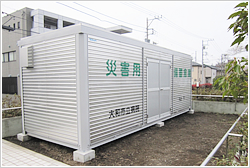Disaster base hospitals are hospitals that have the function of supporting local medical institutions, and are positioned as hospitals that play a central role in medical rescue activities in the event of a disaster, such as accepting severe and serious injuries. .
This hospital has been designated as a disaster base hospital in the central part of Kanagawa Prefecture since March 1998.
The following functions are required for disaster base hospitals.
Functions required of disaster base hospitals
- Advanced medical care functions for performing life-saving care
- Function to accept severely ill patients from affected areas
- Function to respond to wide-area backward transport of victims
- Dispatching function of medical rescue teams
- Lending function for emergency medical equipment to regional medical institutions
This hospital is taking the following measures to fulfill its role as a disaster base hospital.
Main Initiatives at Daiwa Municipal Hospital
- Kanagawa DMAT designated hospital
- Installation of Disaster Storage Warehouse
- Conducting training to accept victims
- Satellite Telephone Installation
- Development of medical equipment and materials
- Additional fuel tanks for emergency power generation
Kanagawa DMAT designated hospital
Yamato City Hospital was certified by Kanagawa Prefecture in March 2013 as a "Kanagawa DMAT Designated Hospital".
Our hospital's DMAT has a total of seven people, one doctor, four nurses, and two business coordinators.
We will strive for training and training to improve technology, etc., secure a medical system in the event of a disaster so that we can always be dispatched, and further strengthen the function as a disaster base hospital.
What is DMAT?
Disaster dispatch medical team Disaster Medical Assistance Team is called DMAT (Daimat).
In the event of a large-scale natural disaster or aircraft accident, this is a professionally trained medical team with the mobility to quickly rush to the affected area and work within 48 hours, which is said to be the acute phase of the disaster.


- An earthquake with a seismic intensity of 6 or less occurred in the prefecture
- Disasters in which 20 or more victims occur or are expected to occur


- There is a request from the affected municipalities to dispatch Kanagawa DMAT, and the governor decided that dispatch Kanagawa DMAT is appropriate.
- The governor determined that it is appropriate to dispatch Kanagawa DMAT in response to the disaster that occurred.
- When dispatching to other prefectures, there is a request from the affected prefectural governor, etc., and the governor determines that it is appropriate to dispatch Kanagawa DMAT.

- The governor requested the dispatch of Kanagawa DMAT, and Kanagawa DMAT is dispatched (within 48 hours)
DMAT's activities
When there is a request for dispatch of Kanagawa DMAT, the following activities will be performed.
- On-site activities: Triage in cooperation with fire department ※Emergency treatment
- Transport within the region: Transport of patients in the affected areas and treatment during transport
- Hospital support: Treatment at disaster base hospitals in the affected areas
- Wide-area medical transport: Transportation of critically ill patients who are difficult to respond within the affected areas.
※Triage is a system that separates a large number of victims according to severity and urgency in the event of a disaster, etc., and determines the priority of treatment.

Installation of Disaster Storage Warehouse
In the event of a disaster, we have prepared emergency stockpiles.

Training for Acquisition
Our hospital is expected to accept many victims in the event of a disaster.
To fulfill our role as a disaster base hospital, we regularly conduct training on receiving victims (triage) training.

Satellite Telephone Installation
In the Great East Japan Earthquake that occurred on March 11, 2011, there were hospitals in the affected areas that could not be contacted until the next day, such as telephone lines, mobile phones, and Internet lines were interrupted. In some cases, emergency input into the Disaster Emergency Medical Information System (EMIS) could not be entered.
In preparation for the occurrence of a large-scale disaster, our hospital is equipped with equipment that can be connected to EMIS via satellite lines.
